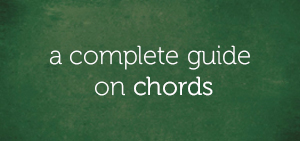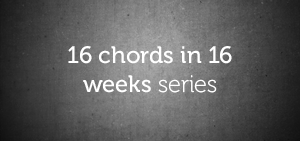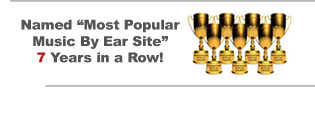A vast majority of musicians under-utilize major triads and major seventh chords in the major key.
But in this lesson, you’ll change the way you look at major triads and major seventh chords in the major key and also be able to explore other hidden functions of these chords that a lot of musicians don’t apply.
If you’re a jazz or gospel musician, you’ll learn a whole lot from this lesson and you’ll no longer run out of ideas on what to do over major triads and major seventh chords.
Let’s start by refreshing our minds on the major triads and major seventh chords in the major key.
A Revision On The Major Triads And Major Seventh Chords
There are three categories of major chords in the major key:
Major triads
Major seventh chords
Extended major chords
However, we’ll be exploring the power of major triads and major seventh chords in the major key and we’ll be using the key of C major as a reference.
Major Triads In The Major Key
There are three major triads in the major key and they are generally classified as primary triads. They’re the 1-chord, 4-chord, and 5-chord.
In the key of C major:
…the primary triads are as follows:
1-chord:
4-chord:
5-chord:
…and they’re the C major triad, F major triad, and G major triad respectively. So, keep in mind that there are three major triads and then the following numbers: 1, 4, and 5.
Major Seventh Chords In The Major Key
In the major key, there are two major seventh chords: the 1-chord and the 4-chord.
“Pause For A Minute…”
Now you’re probably wondering why there are three major triads and two major seventh chords.
Well, the 5-chord is a special major chord type known as the dominant chord. So, although it’s a major chord, but it doesn’t have a major seventh like the 1-chord and the 4-chord.
“Back To The Major Seventh Chords In The Key…”
In the key of C major:
…the major seventh chords in the key are as follows:
C major seventh chord (which is the 1-chord):
F major seventh chord (which is the 4-chord):
Again, keep in mind that there are only two major seventh chords in the major key and the numbers associated with them are 1 and 4.
The Power Of Major Triads In The Major Key
Every triad in the major key has up to three functions and functions as a link to two other keys.
Until you understand and apply every single triad in the major key, taking advantage of all their functions, you may still belong to the league of musicians who under-utilize triads.
I’ll show you other functions of the 1-chord and let you figure the functions of the 4-chord and 5-chord.
Deal?
The 1-chord — Explored
The C major triad:
…is the 1-chord in the key of C major:
However, it has three functions: the 1-chord function, the 4-chord function, and the 5-chord function. A closer look at all these functions will blow your mind.
Attention: I’ll assume that you’re already familiar with the 1-chord function. So, we’ll go straight to the 4-chord function and the 5-chord function.
“The 4-Chord Function Of The 1-chord…”
The C major triad:
…is the 4-chord in the key of G major:
Consequently, you can borrow C major ideas from the key of G major and a classic example is playing the G major scale:
…from C to C:
…to produce the C Lydian scale:
…which is a great scale option to improvise over the C major triad with.
That’s not all. There’s also a 5-chord function of the 1-chord in the major key that I’m going to show you right away.
“The 5-Chord Function Of The 1-chord…”
The 1-chord in the key of C major (which is the C major triad):
…can function as a 5-chord (aka – “dominant chord”) in the key of F major:
…and that’s why you can explore ideas from the key of F major over the C major triad.
Playing the F major scale:
…from C to C:
…to produce the C Mixolydian scale:
…which has a bluesy sound that we all love.
The Power Of Major Seventh Chords
There are two ways to apply to every major seventh chord in the major key and once you figure these two ways out, you’ll have a fresh perspective to the 1-chord and 4-chord in the key.
Attention: Everything we’re covering in this segment will be in the key of C major.
I’ll show you a fresh perspective to the 4-chord in the key of C major (which is the F major seventh chord), then I’ll let you explore the power of the 1-chord.
The 4-chord (The C Major Seventh)
The 4-chord in the key of C major:
…is the F major seventh chord:
In the previous segment, we learned that there are two major seventh chords in the major key. Consequently, every major seventh chord in the major key can take up the function of these two major seventh chords either as the 1-chord or the 4-chord.
Thinking in this direction gives us two applications of the major seventh chord in the major key:
The major seventh chord as the 1-chord
The major seventh chord as the 4-chord
The F major seventh chord is usually applied as the 4-chord in the key of C major. Therefore, we’ll be focusing on the application of the F major seventh chord as the 1-chord.
“The F Major Seventh Chord As The 1-chord…”
The F major seventh chord:
…is the 1-chord in the key of F major:
Does this link us up to the key of F major? Sure it does.
Improvising with the F major scale:
…over the F major seventh chord:
…in the key of C major:
…sounds spicier because of the Bb note that is foreign to the key of C major:
Chuku Onyemachi
Latest posts by Chuku Onyemachi (see all)
- The Formation Of Diminished Seventh Chords Used To Be Challenging Until I Did This
- How To Form Seventh Chords In Two Shakes Of A Dog’s Tail Using Third Intervals And The Circle Of Fifths Chart
- I Played The 13sus4 Chord And This Happened…
- How To Build Seventh Chords Like An Architect Using “Foundation And Structure” Concept
- This 4-Week Plan Will Help You Master All The Major Scales







Comments on this entry are closed.